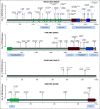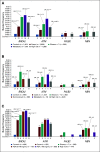Pathogenic Variants in Cancer Predisposition Genes and Prostate Cancer Risk in Men of African Ancestry
- PMID: 32832836
- PMCID: PMC7442213
- DOI: 10.1200/po.19.00179
Pathogenic Variants in Cancer Predisposition Genes and Prostate Cancer Risk in Men of African Ancestry
Abstract
Purpose: In studies of men of European ancestry, rare pathogenic variants in DNA repair pathway genes have been shown to be associated with risk of aggressive prostate cancer. The contribution of rare coding variation to prostate cancer risk in men of African ancestry has not been established.
Methods: We sequenced a panel of 19 DNA repair and cancer predisposition genes in 2,453 African American and 1,151 Ugandan prostate cancer cases and controls. Rare variants were classified as pathogenic or putatively functionally disruptive and examined in association with prostate cancer risk and disease aggressiveness in gene and pathway-level association analyses.
Results: Pathogenic variants were found in 75 out of 2,098 cases (3.6%) and 31 out of 1,481 controls (2.1%) (OR=1.82, 95% CI=1.19 to 2.79, P=0.0044) with the association being stronger for more aggressive disease phenotypes (OR=3.10, 95% CI=1.54 to 6.23, P=0.0022). The highest risks for aggressive disease were observed with pathogenic variants in the ATM, BRCA2, PALB2 and NBN genes, with odds ratios ranging from ~4 to 15 in the combined study sample of African American and Ugandan men. Rare, non-pathogenic, non-synonymous variants did not have a major impact on risk of overall prostate cancer or disease aggressiveness.
Conclusions: Rare pathogenic variants in DNA repair genes have appreciable effects on risk of aggressive prostate cancer in men of African ancestry. These findings have potential implications for panel testing and risk stratification in this high-risk population.
Conflict of interest statement
Eric C. Polley
Raed Samara
Alexander Lubmawa
Benon Masaba
Stephen Watya
Fergus J. Couch
No other potential conflicts of interest were reported.
Figures


References
-
- Siegel RL, Miller KD, Jemal A. Cancer statistics, 2017. CA Cancer J Clin. 2017;67:7–30. - PubMed
-
- Bray F, Ferlay J, Soerjomataram I, et al. Global cancer statistics 2018: GLOBOCAN estimates of incidence and mortality worldwide for 36 cancers in 185 countries. CA Cancer J Clin. 2018;68:394–424. - PubMed
Grants and funding
LinkOut - more resources
Full Text Sources
Research Materials
Miscellaneous

